LAPS - cutting surfaces
This discussion will limit itself to those laps used in all of the cutting and pre-polishing phases. I use and recommend diamond cutting and pre-polishing laps.
The diamond is most cases bound to the surface of the lap and is considered permanent. They do not require "recharging" and are in fact too hard to recharge. (Recharging: means to replace the diamond by pressing or rolling it back into the surface of the lap.)
A set of flat laps with different grit (mesh) diamond is standardly used for faceting. What is not standard is the mesh of each member of the set. Individual faceters tend to believe that one particular set is best.
I am not going to recommend one set, rather explain the general requirements. (In my opinion.)
|
|
|
|
|
|
|
This one eats up rough, good for preforming and generally laying in the rough facet positions. Should not be used with brittle material as it will cause chipping. Not included in many faceters selection. Considered by some too rough. |
|
|
|
This one eats up rough, but more controlled than the previous ones, and less chipping. Produces a reasonable smooth surface but frosted in appearance. |
|
|
|
Aggressive but smooth cutting, Good for cutting facets almost to finished position. Creates an translucent finish. Can be used safely with more brittle materials. Also good as a starter lap on very soft materials. |
|
|
|
Almost aggressive cutting, steady removal of material, but not really aggressive. produces an almost clear facet. Really good for cutting to final position and roughing in the exact meet points. |
|
|
|
Finishes all meet points, and produces a nearly clear facet. There are two thoughts at this level and one is a standard diamond lap and the other a copper lap with diamond compound. |
|
|
|
A sort of pre-prepolish. Really get all meet points as sharp as desired, get a uniform clear but scratch free surface on all facets. Cut out any visible remaining deep scratches. |
|
|
|
Get a uniform surface on each facet so that polishing is quick and efficient. Of little cutting value, but minor movement of meet points can be achieved. |
|
|
|
Get a uniform surface on each facet so that polishing is quick and efficient. Of little cutting value, but minor movement of meet points can be achieved. (Does this sound familiar.) OK, it is a little less aggressive than the non-aggressive 3000. |
|
|
|
Makes a pleasing sound when in contact with a facet. Most users are still waiting to see if it actually does anything to a hard surface or not. (Many polish laps are more aggressive.) (OK, so I couldn't resist a little editorial comment.) |
The coarse and medium laps do a good job right out of the box. They are aggressive and are designed to cut quickly. The other laps will actually cut better after they have been used. There is a "break-in" period for each, and the time varies with the mesh size. The finer laps 3000 and 8000 often leave undesirable scratches for a time until they have seen some use. They do smooth out with use. It is usually a good idea to cut a few harder stones (synthetics) on these laps to help break them in.
Although the bonded diamond laps are not prone to cross contamination, it is always a good idea to store them separately and in their own containers. Clean them well before and after use. Dry them and do not store them with water drops or they CAN RUST. As it happens several companies offer old "film cans" to store 8" or 6" laps in. They make excellent storage containers.
Larger mesh laps are normally more expensive than fine mesh laps up to a pint, then the finer ones go back up in price. At one end it is because they have more diamond compound, and at the other it is because they must achieve higher purity.
Laps come in two sizes 6" and 8". Do the math ... (pi x radius squared)
The 8" laps are usually about 30% more in cost than the 6" but gives you almost 2X (twice) as much diamond surface, so they tend to be more cost effective.
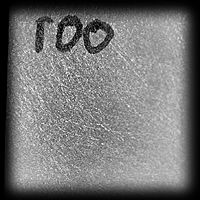
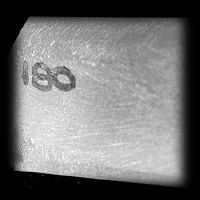
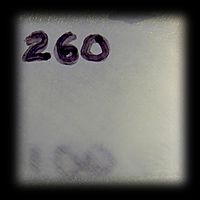
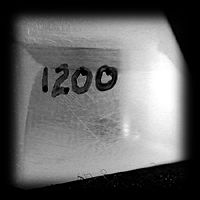
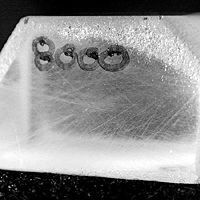
Here are some quartz surfaces that have been ground with the same mesh lap as shown on the surface. They were not finished pieces, rather just a visual example of what each of the laps produces. On a real facet, the 8000 lap would produce a nearly clear surface with none of the large scratches present in this image.
The 100 and 180 show deep score marks randomly laced all over the surface, there is obviously no reason to try and do fine work with these two laps. The 260 begins to show a smooth surface with a grainy pattern rather than long scratches randomly place. This is the first lap that should be used to actually place and meet the facets.
The 1200 and 8000 both show many long scratches, but these are from previous grits. The areas of interest are the areas between the scratches. Here you can begin to see the kind of finish each mesh will produce. Since they differentiate scratches they are beginning to polish.


